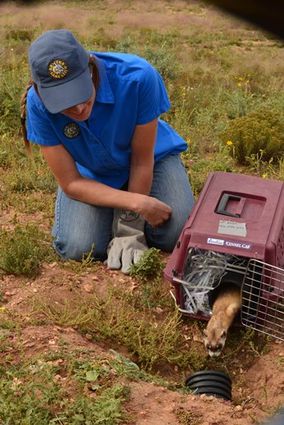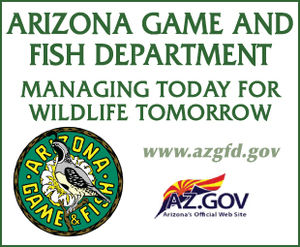Black-Footed Ferrets Have Recovery Chances Renewed
New Espee Ranch population will help achieve Arizona's recovery goals.
October 15, 2014
Arizona's endangered black-footed ferret population accomplished several steps towards recovery today with the release of 25 animals on the private Espee Ranch, a working, northern Arizona cattle ranch owned by Babbitt Ranches.
Officials from a variety of partner organizations including Babbitt Ranches, U.S. Fish and Wildlife Service, Arizona Game and Fish Department, U.S. Geological Survey, U.S. Department of Agriculture (APHIS Wildlife Services, U.S. Department of Agriculture), Natural Resources Conservation Service, and Hualapai Nation, released ferrets to an area with a robust prairie dog population.
Significant Accomplishments
"Milestones like this release of endangered ferrets onto private land are significant accomplishments on the road to meeting Arizona - and national - recovery goals," said Larry Voyles, director of the Arizona Game and Fish Department.
"It's a true demonstration of the power of cooperative wildlife conservation because ferret recovery would never have been possible without our partners at Babbitt Ranches, U.S. Fish and Wildlife Service, Phoenix Zoo, Navajo Nation and others."
Ferrets Depend on Prairie Dogs
Successful ferret recovery depends on the presence of healthy prairie dog colonies, a ferret's primary prey. To help ensure that the Espee Ranch maintains a robust prairie dog population, a new vaccine field trial was also initiated in conjunction with the ferret release.
Vaccine-laden bait developed in part by U.S. Geological Survey is being studied as a potential means for reducing the incidence of sylvatic plague in prairie dogs. Sylvatic plague can decimate entire prairie dog colonies. The new vaccine being field tested may also prove to have human health benefits if it is effective.
Safe Harbor Agreement
This release of ferrets onto private land in Arizona was made possible through a Safe Harbor Agreement, a special tool under the Endangered Species Act that encourages private landowners to conserve endangered species on their property with minimal land-use restrictions.
Espee Ranch is the first landowner in Arizona to use a Safe Harbor Agreement for black-footed ferret conservation. Safe Harbor Agreements have been used in Arizona with other species like the threatened Chiricahua leopard frog.
"Many ranchers accommodate endangered species needs into their livestock operations," said Steve Spangle, Fish and Wildlife Service's Arizona field supervisor. "A Safe Harbor Agreement allows them to participate in species recovery while simplifying and guaranteeing certainty for their business options in the future."
Recovery Guidelines
Arizona's first population of black-footed ferrets in the Aubrey Valley is doing well since being reintroduced in 1996 and is now self-sustaining, meaning it no longer requires the supplemental release of ferrets to keep the population healthy and growing. Establishing a second self-sustaining ferret population on the Espee Ranch would help Arizona achieve one of its recovery goals for conserving the species.
All states with black-footed ferret populations are given state-specific recovery guidelines that lead to a larger national recovery effort. The national recovery guidelines must be met before "delisting" the species can be considered.
Babbitt Ranches
Babbitt Ranches has been involved in the discussions and efforts of the reintroduction of the black-footed ferret since the early 2000s.
As a landowner, developing our awareness, responsibility and obligation to landscape conservation, science and the health of wildlife and wildlife habitat, the owners and employees are committed to Babbitt Ranches' values of accountability to the land community," said Babbitt Ranches President Bill Cordasco.
"Additionally, the effort involving the vaccination of prairie dogs against plague is particularly significant as it may prove to have human health implications on a global level. This is particularly timely as communities east of Flagstaff have been made aware of a recent plague outbreak in prairie dogs."
Species Saved
In the late 1970s, the species was thought to be extinct until a small colony of approximately 120 ferrets was discovered near Meeteetse, Wyo. on Sept. 26, 1981. Disease outbreaks reduced that population to 18 individuals, which were captured in 1985 to begin a captive breeding program to save the species.
The descendants of the original 18 ferrets have now been introduced into reintroduction sites nationwide, including the Aubrey Valley. Before reintroduction, the last black-footed ferret in Arizona was found in 1931 in an area between Williams and Flagstaff. The last survey of the Aubrey Valley ferret population showed a population of at least 100 adult ferrets.
Only Native North American Ferret
Because not all ferrets were captured and included in the survey count, the number of animals identified during the survey is a minimum population estimate, and the actual population could be larger. Arizona's potential contribution to ferret recovery is 148 adult ferrets.
While they resemble domestic pet ferrets, black-footed ferrets are a different species and are the only ferret native to North America. They can grow to be up to 2 feet long and can weigh up to 2.5 pounds. One ferret can give birth to three to five kits each year.
Additional Partners
Additional partners in the Arizona black-footed ferret reintroduction program include the Hualapai Tribe, Havasupai Tribe, Hopi Tribe, Arizona State Land Department, Kaibab National Forest, and the Cholla Cattle Company.
Note: This historic release of endangered black-footed ferrets to a private working ranch is a first in Arizona under special federal conservation agreement















Reader Comments(0)